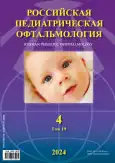Evaluation of visual performance depending on tolerability of optical correction
- 作者: Zhukova O.V.1, Zolotarev A.V.1, Abida M.1
-
隶属关系:
- Samara State Medical University
- 期: 卷 19, 编号 4 (2024)
- 页面: 191-199
- 栏目: Original study article
- URL: https://journal-vniispk.ru/1993-1859/article/view/281626
- DOI: https://doi.org/10.17816/rpoj637443
- ID: 281626
如何引用文章
详细
Accommodative asthenopia is common in myopic patients when permanent full correction is prescribed, since their accommodative system does not tolerate increased stress due to close work.
AIM: To evaluate visual performance in myopic school children depending on tolerability of optical correction.
MATERIAL AND METHODS: A total of 154 children (11 to 16 years) with different levels of myopia, wearing corrective spectacles. Of them, 56 and 98 school children had good and poor tolerability of optical correction according to computed accommodation test, respectively. Accommodation was measured using autorefractor Righton Speedy-K ver. MF-1. Visual performance was evaluated using Bourdon test. Performance accuracy (At), accuracy factor (Ta), productivity (Pt), endurance factor (Kp), and speed of information processing (S) were determined.
RESULTS: In the group where spectacle correction caused asthenopia during visual tasking, performance accuracy, productivity, and accuracy factor exceeded the mean values in children without signs of accommodative asthenopia. But endurance factor and speed of information processing are significantly lower compared to the children with good tolerability of optical correction.
CONCLUSION: Tolerability of optical correction affects visual performance of school children. Poor tolerability of optical correction significantly decreases visual performance parameters, such as performance accuracy, productivity, and endurance.
作者简介
Olga Zhukova
Samara State Medical University
编辑信件的主要联系方式.
Email: olga-g@list.ru
ORCID iD: 0000-0003-1246-370X
SPIN 代码: 4123-1890
MD, Dr. Sci. (Medicine)
俄罗斯联邦, SamaraAndrey Zolotarev
Samara State Medical University
Email: a.v.zolotarev@samsmu.ru
ORCID iD: 0000-0002-9107-5221
SPIN 代码: 7164-8088
MD, Dr. Sci. (Medicine), Associate Professor
俄罗斯联邦, SamaraMahdi Abida
Samara State Medical University
Email: dr.abida.mahdi@yandex.ru
ORCID iD: 0000-0002-0758-5254
SPIN 代码: 3876-3440
Оphthalmologist
俄罗斯联邦, Samara参考
- Avetisov SE, Kazarian EE, Mamikonian VR, et al. Results of a complex evaluation of the accommodative asthenopia in using different-design video monitors. Russian Annals of ophthalmology. 2004;120(3):38–40. EDN: TUEQZP
- Avetisov SE, Pershin KB. Criteria of estimating the results of keratorefractive operations. Oftal’mokhirurgiya i terapiya. 2001;1(1):12–16. EDN: HVEMAZ
- Andreeva MS, Nikiforova AA, Korotkikh SA. Сomputer visual syndrome epidemiology and risk factors. In: Actual issues of modern medical science and health care: materials of the II International (72 All-Russian) scientific-practical conference of young scientists and students, II All-Russian forum of medical and pharmaceutical universities “For quality education”, 12–14 April. Vol. 2. Ekaterinburg; 2017. Р. 495–500. EDN: YSUGDW
- Bakutkin IV, Spirin VF, Bakutkin VV. Early diagnosis of visual fatigue and myopia in conditions of high visual load during the working shift. In: Profession and health: materials of the XI All-Russian Congress, 27-29 November 2012. Ed. by N.F. Izmerov. Moscow: REINFOR; 2012. Р. 75–76. (In Russ.)
- Ignatyev SA, Kornyushina TA, Shapovalov SL, Milyavskaya TI. Visual fatigue when working with video-display terminals and modern methods of its prevention. Moscow: MIK (Mezhdunarodnaya intellektual’naya kniga); 2013. 240 р. (In Russ.)
- Abida M, Zhukova OV, Sineok AE, et al. Computer accomodography data for assessing tolerability of optical correction for myopia in near work. Aspirantskiy vestnik Povolzhiya. 2023;23(4):10–14. EDN: GRSSLD doi: 10.55531/2072-2354.2023.23.4.10-14
- Kornyushina TA. Physiological mechanisms of development of visual fatigue when performing visually strenuous work. Russian Annals of ophthalmology.2000;116(4):33–36. (In Russ.)
- Kornyushina TA. Physiological mechanisms of development of visual fatigue and overstrain and measures of their prevention [dissertation abstract]: 14.00.05. Place of defence: Moscow Research Institute of Eye Diseases Helmholtz. Moscow; 1999. 46 р. (In Russ.) EDN: NJMGXL
- Somov EE. Methods of ophthalmic ergonomics. Saint Petersburg; 1989. 158 р. (In Russ.) EDN: VWIZDP
- Shapovalov SL, Milyavskaya TI, Ignatiev SA. Basic forms of asthenopia. Moscow: MIK (Mezhdunarodnaya intellektual’naya kniga); 2012. 288 р. (In Russ.)
- Brzeskii VV, Vorontsova TN, Golubev SY, et al. Accomodation: a guide for doctors. Ed. by L.A. Katargina. Moscow: April; 2012. 136 р. (In Russ.)
- Kornyushina TA, Kupriyanova MV, Ibatulin RA, et al. Features of refraction development in schoolchildren according to studies length. Fyodorov journal of ophthalmic surgery. 2010;(6):40–43. EDN: PXRAPT
- Kornyushina TA, Magaramova MD, Ibragimov AV. Recovery of accommodation ability in schoolchildren with paralysis and paresis of accommodation. Fyodorov journal of ophthalmic surgery. 2011;(4):45–48. EDN: PXRBML
- Liu G, Chen Z, Xue F, et al. Effects of myopic orthokeratology on visual performance and optical quality. Eye Contact Lens. 2018;44(5):316–321. doi: 10.1097/ICL.0000000000000372
- Collins JW, Carney LG. Visual performance in high myopia. Curr Eye Res. 1990;9(3):217–223. doi: 10.3109/02713689009044516
- Mukhacheva EV, Naumova TA. Pedagogical diagnostics: methods and techniques. Educational and methodological manual. Izhevsk: Udmurtskii universitet; 2020. 425 р. (In Russ.) EDN: CHSKUY
- Zharov VV, Egorova AV, Konkova LV. Complex treatment of accommodative disorders in acquired myopia: monograph. Izhevsk: Nauchnaya kniga; 2008. 104 р. (In Russ.)
- Voronin IA, Merzon LA, Ismatullina VI. The structure of individual differences in the speed of information processing and its relationships with working memory and intelligence: twin research. Theoretical and experimental psychology. 2020;13(1):22–32. EDN: YILZCZ
补充文件












